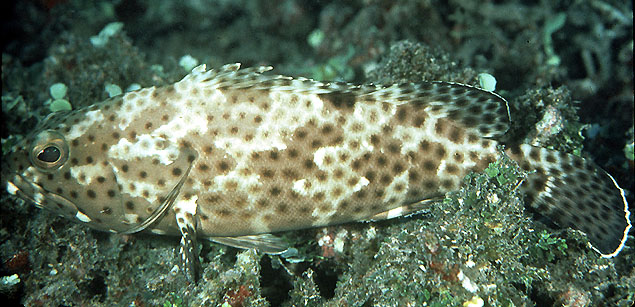| Epinephelidae (Groupers) |
| 55 cm TL (male/unsexed) |
|
reef-associated; marine; depth range 1 - 37 m |
| Western Pacific: Ryukyu Islands south to Lord Howe Island and east to Howland Island and Samoa. Often misidentified as Epinephelus macrospilos or Epinephelus corallicola. |
|
Dorsal spines (total): 11-11; Dorsal soft rays (total): 15-17; Anal spines: 3-3; Anal soft rays: 8-8. Distinguished by the following characteristics: head and body pale grey or brownish grey, covered with small brownish black spots with diffuse edges, separated from adjacent spots by spaces equal to or greater than width of the spots; body with black saddle blotch , smaller black saddle blotch on the caudal peduncle; dusky margins of the soft dorsal, caudal and anal fins, with white line along edge; median and pelvic fins with dark spots; dusky pectoral fins with few dark spots basally; body depth contained 2.9-3.3 times in SL; HL 2.2-2.5 times in SL; flat interorbital area, convex dorsal head profile; rounded preopercle, slightly enlarged serrae at angle; maxilla reaches past vertical at rear edge of eye; 2-4 rows of teeth on the midlateral part of lower jaw; pyloric caeca 13 (Ref. 89707). |
| Usually found over rocky areas or on coral reefs. Feeds on fishes and crustaceans (shrimps and crab) with occasional molluscs or worms (Ref. 89707). Nothing has been published on its biology. Appears to be very rare and therefore of little commercial importance. In Hong Kong live fish markets (Ref. 27253). |
|
Least Concern (LC); Date assessed: 22 November 2016 Ref. (130435)
|
| harmless |
|
Source and more info: www.fishbase.org. For personal, classroom, and other internal use only. Not for publication.

